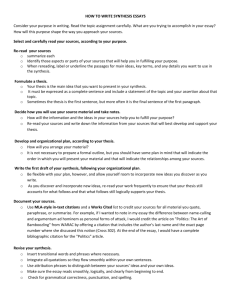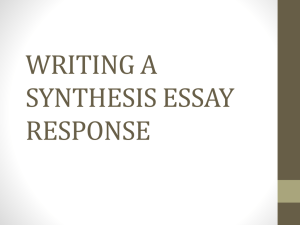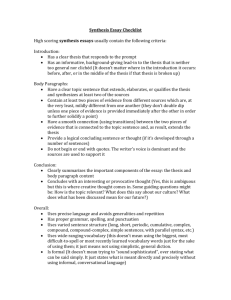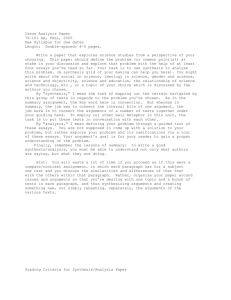Document 7862665
advertisement
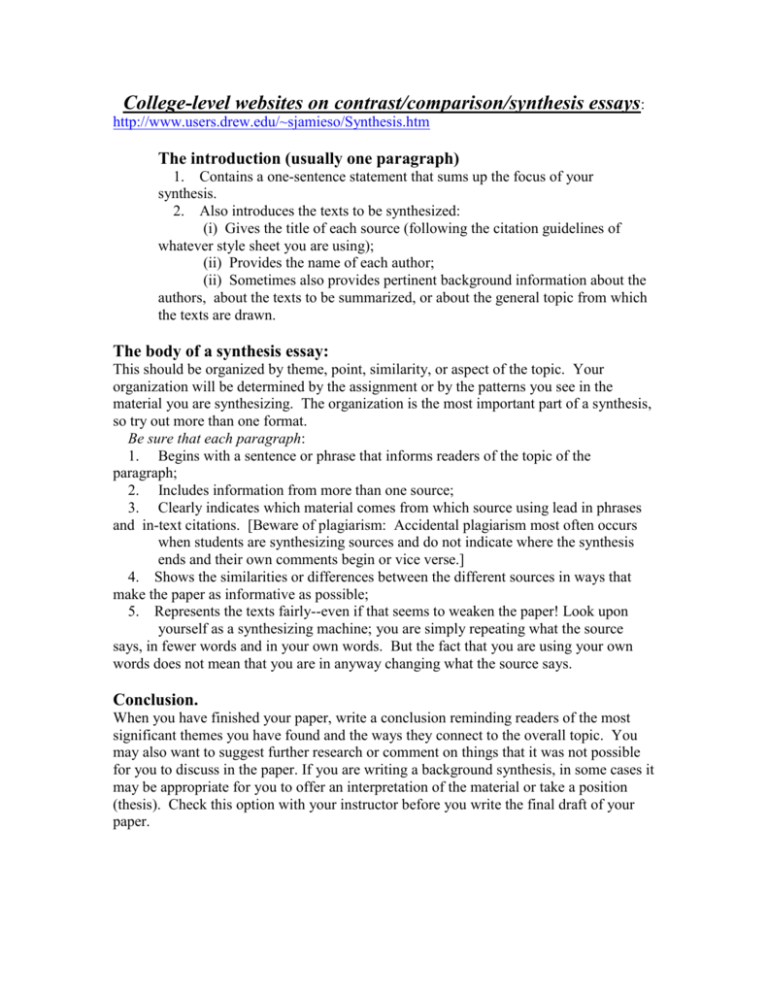
College-level websites on contrast/comparison/synthesis essays: http://www.users.drew.edu/~sjamieso/Synthesis.htm The introduction (usually one paragraph) 1. Contains a one-sentence statement that sums up the focus of your synthesis. 2. Also introduces the texts to be synthesized: (i) Gives the title of each source (following the citation guidelines of whatever style sheet you are using); (ii) Provides the name of each author; (ii) Sometimes also provides pertinent background information about the authors, about the texts to be summarized, or about the general topic from which the texts are drawn. The body of a synthesis essay: This should be organized by theme, point, similarity, or aspect of the topic. Your organization will be determined by the assignment or by the patterns you see in the material you are synthesizing. The organization is the most important part of a synthesis, so try out more than one format. Be sure that each paragraph: 1. Begins with a sentence or phrase that informs readers of the topic of the paragraph; 2. Includes information from more than one source; 3. Clearly indicates which material comes from which source using lead in phrases and in-text citations. [Beware of plagiarism: Accidental plagiarism most often occurs when students are synthesizing sources and do not indicate where the synthesis ends and their own comments begin or vice verse.] 4. Shows the similarities or differences between the different sources in ways that make the paper as informative as possible; 5. Represents the texts fairly--even if that seems to weaken the paper! Look upon yourself as a synthesizing machine; you are simply repeating what the source says, in fewer words and in your own words. But the fact that you are using your own words does not mean that you are in anyway changing what the source says. Conclusion. When you have finished your paper, write a conclusion reminding readers of the most significant themes you have found and the ways they connect to the overall topic. You may also want to suggest further research or comment on things that it was not possible for you to discuss in the paper. If you are writing a background synthesis, in some cases it may be appropriate for you to offer an interpretation of the material or take a position (thesis). Check this option with your instructor before you write the final draft of your paper. Checking your own writing or that of your peers Read a peer's synthesis and then answer the questions below. The information provided will help the writer check that his or her paper does what he or she intended (for example, it is not necessarily wrong for a synthesis to include any of the writer's opinions, indeed, in a thesis-driven paper this is essential; however, the reader must be able to identify which opinions originated with the writer of the paper and which came from the sources). 1. What do you like best about your peer's synthesis? (Why? How might he or she do more of it?); 2. Is it clear what is being synthesized? (i.e.: Did your peer list the source(s), and cite it/them correctly?); 3. Is it always clear which source your peer is talking about at any given moment? (Mark any places where it is not clear); 4. Is the thesis of each original text clear in the synthesis? (Write out what you think each thesis is); 5. If you have read the same sources, a. did you identify the same theses as your peer? (If not, how do they differ?); b. did your peer miss any key points from his or her synthesis? (If so, what are they?); c. did your peer include any of his own opinions in his or her synthesis? (If so, what are they?); 6. Where there any points in the synthesis where you were lost because a transition was missing or material seems to have been omitted? (If so, where and how might it be fixed?); 7. What is the organizational structure of the synthesis essay? (It might help to draw a plan/diagram); 8. Does this structure work? (If not, how might your peer revise it?); 9. How is each paragraph structured? (It might help to draw a plan/diagram); 10. Is this method effective? (If not, how should your peer revise?); 11. Was there a mechanical, grammatical, or spelling error that annoyed you as you read the paper? (If so, how could the author fix it? Did you notice this error occurring more than once?) Do not comment on every typographical or other error you see. It is a waste of time to carefully edit a paper before it is revised! 12. What other advice do you have for the author of this paper? https://frontpage.northseattle.edu/eng101tc/Handouts/synthesis.htm What is synthesis? When you synthesize two or more texts in an essay, you find connections between the texts. How is synthesis different from compare and contrast? In some ways, these two activities are similar. But think of synthesis as going beyond compare and contrast; in general, it is a more complex intellectual task. Instead of looking at two separate things and finding similarities or differences, you focus on how these two things (texts, in this case) actually work together to create a deeper understanding of a theme or idea. https://www.owens.edu/writing/synthesis.html What is a synthesis? A synthesis is a written discussion incorporating support from several sources of differing views. This type of assignment requires that you examine a variety of sources and identify their relationship to your thesis. Tips for an effective synthesis essay: Select your sources and become familiar with them so that you can discuss them in relationship to your thesis and supporting argument(s). If you simply quote sources without evaluating them then the sources will control your paper and your audience will/ may misinterpret the information. Strategies for organization: Climactic order- arranges the most important/persuasive evidence last since this is what is remembered. Problem/solution-establishes the problem in the introduction, then offers a few solutions. Comparison and contrasto Summarizes each source and shows their similarities and differences o Can move from point-to-point, back and forth between items being compared. o Can be set into blocks, where one item is completely discussed before moving on to the next. https://www.msu.edu/~jdowell/135/Synthesis.html TECHNIQUES FOR DEVELOPING SYNTHESIS ESSAYS STRAWMAN: When you use the strawman technique, you present an argument against your thesis, but immediately afterward you show that this argument is weak or flawed. The advantage of this technique is that you demonstrate your awareness of the other side of the argument and show that you are prepared to answer it. The strawman argument first presents an introduction and thesis, then the main opposing argument, a refutation of the opposing argument, and finally a positive argument. CONCESSION: Like the strawman, the concession technique presents the opposing viewpoint, but it does not proceed to demolish the opposition. Instead, it concedes that the opposition has a valid point but that, even so, the positive argument is the stronger one. This method is particularly valuable when you know your reader holds the opposing view. COMPARISON AND CONTRAST: Comparison and contrast techniques enable you to examine two subjects (or sources) in terms of one another. When you compare, you consider similarities. When you contrast, you consider differences. By comparing and contrasting, you perform a multifaceted analysis that often suggests subtleties that otherwise might not have come to your attention. To organize a comparison/contrast analysis, you must carefully read sources in order to discover significant criteria for analysis. A criterion is a specific point to which both of your authors refer and about which they may agree or disagree. The best criteria are those that allow you not only to account for obvious similarities and differences between sources but also to plumb deeper, to more subtle and significant similarities and differences. There are two basic formulas for comparison/contrast analysis: BY SOURCE BY CRITERIA I. Introduce essay, state thesis I. Introduce essay, state thesis II. Summarize passage A II. Introduce Criterion 1 A. View on Criterion I A. Passage A's viewpoint B. View on Criterion 2 B. Passage B's viewpoint III. Summarize passage B III. Introduce Criterion 2 A. View on Criterion 1 A. Passage A's viewpoint B. View on Criterion 2 B. Passage B's viewpoint IV. Discussion and conclusion IV. Discussion and conclusion http://www.berkeleyprep.org/faculty/lukacpat/apsyn.htm [AP English] After you have brainstormed by making many long lists (much longer than the examples above), begin to play around with combinations. (Actually, my comparison list and my contrast list have both been restricted from what were once much longer lists.) See which combinations can most easily be worked into an arguable and restricted thesis. Your thesis must be as specific and as controversial as possible. When possible, assert cause and effect in your thesis (This is one way to be sure that your thesis is arguable). Don’t be afraid to expand or restrict your ideas as you experiment. For example, the point that all three protagonists feel trapped by social conventions is too general and insignificant to be a meaningful part of any thesis. However, the idea can be transformed to an acceptable thesis: *Similar images of confinement reveal the protagonists’ sense of being suffocated by a society that controls but does not understand them. Introduction: Your first paragraph sets the tone for the entire essay. Make sure you include an attentiongrabber and pertinent reasons for comparing the three works (other than I told you to). Even if your thesis focuses on the differences among the works, you MUST have a common framework in which to contrast them. Make sure you present these reasons in the introduction. You may also include background information about the authors or brief summaries of the two works (no more than a sentence or two each) IF that information helps the reader to understand the focus of the paper. Keep in mind that your audience has read all three works and that your main goal is to offer your unique interpretation relating the works to one another. Thesis—Your thesis may have 0-4 prongs If your thesis does have prongs, they should name SPECIFIC ways in which the works are similar (OR distinct); if the thesis has no prongs, each topic sentence should name a specific similarity or distinction. These specific ways may include abstract qualities, traits, or motifs--NOT character names, settings, or incidents from plot. (general –introduction) Conclusion: Restate the thesis and the main points in a new and interesting way. Do not hesitate to expand your thesis to examine nonliterary implications. For example, from our comparison of images of confinement, we might conclude that an individual’s sense of being trapped is often exacerbated by the individual’s feelings of superiority to the society that controls him or her. For a clincher, you should draw some conclusions about your reasons for comparing/contrasting the three works. Try answering the following question: “How is your understanding and appreciation of the motifs presented by the three works richer now that you have read and analyzed the three works together?
